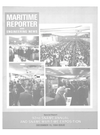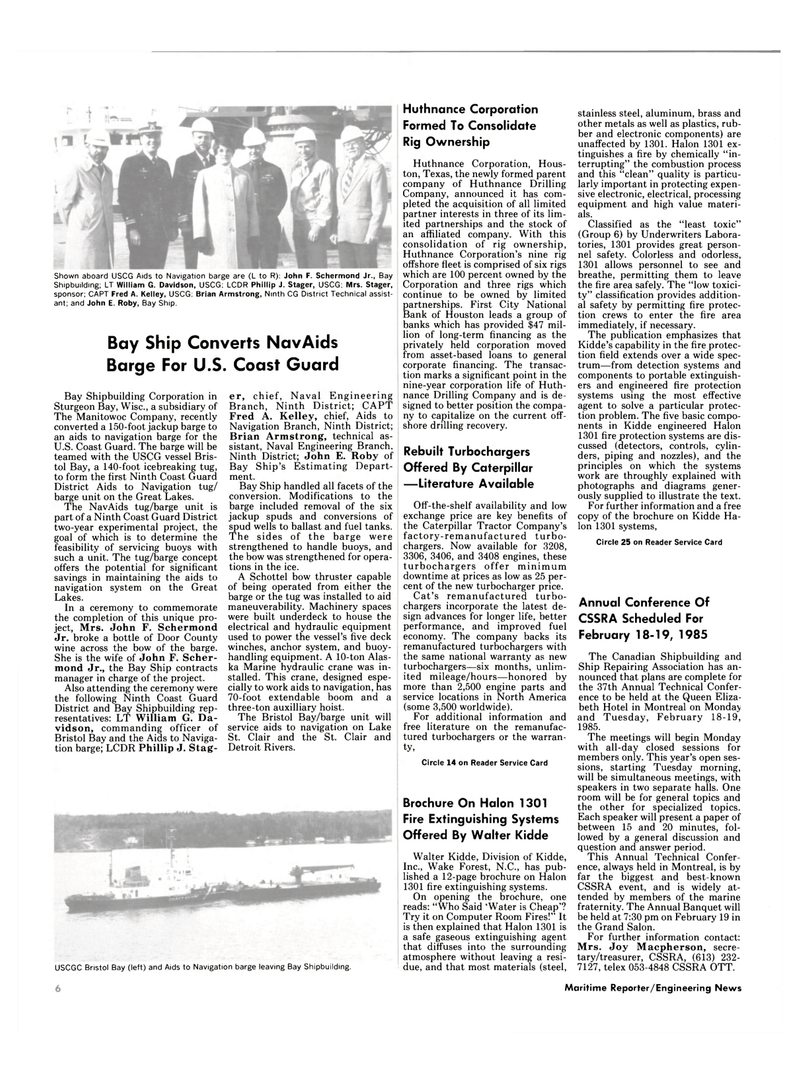
Page 4: of Maritime Reporter Magazine (December 15, 1984)
Read this page in Pdf, Flash or Html5 edition of December 15, 1984 Maritime Reporter Magazine
Shown aboard USCG Aids to Navigation barge are (L to R): John F. Schermond Jr., Bay
Shipbuilding; LT William G. Davidson, USCG; LCDR Phillip J. Stager, USCG; Mrs. Stager, sponsor; CAPT Fred A. Kelley, USCG; Brian Armstrong, Ninth CG District Technical assist- ant; and John E. Roby, Bay Ship.
Bay Ship Converts NavAids
Barge For U.S. Coast Guard
Bay Shipbuilding Corporation in
Sturgeon Bay, Wise., a subsidiary of
The Manitowoc Company, recently converted a 150-foot jackup barge to an aids to navigation barge for the
U.S. Coast Guard. The barge will be teamed with the USCG vessel Bris- tol Bay, a 140-foot icebreaking tug, to form the first Ninth Coast Guard
District Aids to Navigation tug/ barge unit on the Great Lakes.
The NavAids tug/barge unit is part of a Ninth Coast Guard District two-year experimental project, the goal of which is to determine the feasibility of servicing buoys with such a unit. The tug/barge concept offers the potential for significant savings in maintaining the aids to navigation system on the Great
Lakes.
In a ceremony to commemorate the completion of this unique pro- ject, Mrs. John F. Schermond
Jr. broke a bottle of Door County wine across the bow of the barge.
She is the wife of John F. Scher- mond Jr., the Bay Ship contracts manager in charge of the project.
Also attending the ceremony were the following Ninth Coast Guard
District and Bay Shipbuilding rep- resentatives: LT William G. Da- vidson, commanding officer of
Bristol Bay and the Aids to Naviga- tion barge; LCDR Phillip J. Stag- er, chief, Naval Engineering
Branch, Ninth District; CAPT
Fred A. Kelley, chief, Aids to
Navigation Branch, Ninth District;
Brian Armstrong, technical as- sistant, Naval Engineering Branch.
Ninth District; John E. Roby of
Bay Ship's Estimating Depart- ment.
Bay Ship handled all facets of the conversion. Modifications to the barge included removal of the six jackup spuds and conversions of spud wells to ballast and fuel tanks.
The sides of the barge were strengthened to handle buoys, and the bow was strengthened for opera- tions in the ice.
A Schottel bow thruster capable of being operated from either the barge or the tug was installed to aid maneuverability. Machinery spaces were built underdeck to house the electrical and hydraulic equipment used to power the vessel's five deck winches, anchor system, and buoy- handling equipment. A 10-ton Alas- ka Marine hydraulic crane was in- stalled. This crane, designed espe- cially to work aids to navigation, has 70-foot extendable boom and a three-ton auxilliary hoist.
The Bristol Bay/barge unit will service aids to navigation on Lake
St. Clair and the St. Clair and
Detroit Rivers.
USCGC Bristol Bay (left) and Aids to Navigation barge leaving Bay Shipbuilding.
Huthnance Corporation
Formed To Consolidate
Rig Ownership
Huthnance Corporation, Hous- ton, Texas, the newly formed parent company of Huthnance Drilling
Company, announced it has com- pleted the acquisition of all limited partner interests in three of its lim- ited partnerships and the stock of an affiliated company. With this consolidation of rig ownership,
Huthnance Corporation's nine rig offshore fleet is comprised of six rigs which are 100 percent owned by the
Corporation and three rigs which continue to be owned by limited partnerships. First City National
Bank of Houston leads a group of banks which has provided $47 mil- lion of long-term financing as the privately held corporation moved from asset-based loans to general corporate financing. The transac- tion marks a significant point in the nine-year corporation life of Huth- nance Drilling Company and is de- signed to better position the compa- ny to capitalize on the current off- shore drilling recovery.
Rebuilt Turbochargers
Offered By Caterpillar —Literature Available
Off-the-shelf availability and low exchange price are key benefits of the Caterpillar Tractor Company's factory-remanufactured turbo- chargers. Now available for 3208, 3306, 3406, and 3408 engines, these turbochargers offer minimum downtime at prices as low as 25 per- cent of the new turbocharger price.
Cat's remanufactured turbo- chargers incorporate the latest de- sign advances for longer life, better performance, and improved fuel economy. The company backs its remanufactured turbochargers with the same national warranty as new turbochargers—six months, unlim- ited mileage/hours—honored by more than 2,500 engine parts and service locations in North America (some 3,500 worldwide).
For additional information and free literature on the remanufac- tured turbochargers or the warran- ty,
Circle 14 on Reader Service Card
Brochure On Halon 1301
Fire Extinguishing Systems
Offered By Walter Kidde
Walter Kidde, Division of Kidde,
Inc., Wake Forest, N.C., has pub- lished a 12-page brochure on Halon 1301 fire extinguishing systems.
On opening the brochure, one reads: "Who Said 'Water is Cheap'?
Try it on Computer Room Fires!" It is then explained that Halon 1301 is a safe gaseous extinguishing agent that diffuses into the surrounding atmosphere without leaving a resi- due, and that most materials (steel, stainless steel, aluminum, brass and other metals as well as plastics, rub- ber and electronic components) are unaffected by 1301. Halon 1301 ex- tinguishes a fire by chemically "in- terrupting" the combustion process and this "clean" quality is particu- larly important in protecting expen- sive electronic, electrical, processing equipment and high value materi- als.
Classified as the "least toxic" (Group 6) by Underwriters Labora- tories, 1301 provides great person- nel safety. Colorless and odorless, 1301 allows personnel to see and breathe, permitting them to leave the fire area safely. The "low toxici- ty" classification provides addition- al safety by permitting fire protec- tion crews to enter the fire area immediately, if necessary.
The publication emphasizes that
Kidde's capability in the fire protec- tion field extends over a wide spec- trum—from detection systems and components to portable extinguish- ers and engineered fire protection systems using the most effective agent to solve a particular protec- tion problem. The five basic compo- nents in Kidde engineered Halon 1301 fire protection systems are dis- cussed (detectors, controls, cylin- ders, piping and nozzles), and the principles on which the systems work are throughly explained with photographs and diagrams gener- ously supplied to illustrate the text.
For further information and a free copy of the brochure on Kidde Ha- lon 1301 systems,
Circle 25 on Reader Service Card
Annual Conference Of
CSSRA Scheduled For
February 18-19, 1985
The Canadian Shipbuilding and
Ship Repairing Association has an- nounced that plans are complete for the 37th Annual Technical Confer- ence to be held at the Queen Eliza- beth Hotel in Montreal on Monday and Tuesday, February 18-19, 1985.
The meetings will begin Monday with all-day closed sessions for members only. This year's open ses- sions, starting Tuesday morning, will be simultaneous meetings, with speakers in two separate halls. One room will be for general topics and the other for specialized topics.
Each speaker will present a paper of between 15 and 20 minutes, fol- lowed by a general discussion and question and answer period.
This Annual Technical Confer- ence, always held in Montreal, is by far the biggest and best-known
CSSRA event, and is widely at- tended by members of the marine fraternity. The Annual Banquet will be held at 7:30 pm on February 19 in the Grand Salon.
For further information contact:
Mrs. Joy Macpherson, secre- tary/treasurer, CSSRA, (613) 232- 7127, telex 053-4848 CSSRA OTT. 6 Maritime Reporter/Engineering News

 3
3

 5
5
